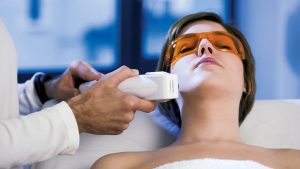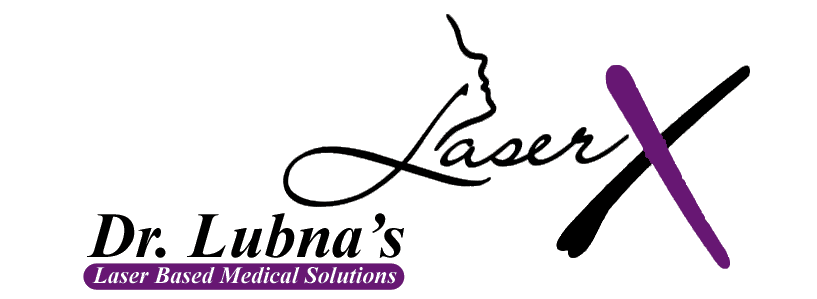Now there is a better solution for unwanted hair…
If you’re not happy with shaving, tweezing, or waxing to remove unwanted hair, laser hair removal may be an option worth considering.
What is Laser Hair Removal? 
Laser hair removal is one of the most commonly done cosmetic procedures in the U.S and UK. It beams highly concentrated light into hair follicles. Pigment in the follicles absorbs the light, that destroys the hair.
Adventure of Laser Hair Removal
Lasers are useful for removing unwanted hair from the face, leg, arm, underarm, bikini line, and other areas.
Benefits of laser hair removal include:
Precision. Lasers can selectively target dark, coarse hair while leaving the surrounding skin undamaged.
Speed
Each pulse of the laser takes a fraction of a second and can treat many hairs at the same time. The laser can treat an area approximately the size of a quarter every second. Small areas such as the upper lip can be treated in less than a minute, and large areas, such as the back or legs, may take up to an hour.
Predictability. Most patients have permanent hair loss after an average of three to seven sessions.
How to Prepare for Laser Hair Removal
Laser hair removal is more than just ”zapping” unwanted hair. It is a medical procedure that requires training to perform and carries potential risks. Before getting laser hair removal, you should thoroughly check the credentials of the doctor or technician performing the procedure.
If you are planning on undergoing laser hair removal, you should limit plucking, waxing, and electrolysis for six weeks before treatment. That’s because the laser targets the hairs’ roots, which are temporarily removed by waxing or plucking.
You should also avoid sun exposure for a few days before and after treatment. Sun exposure makes laser hair removal less effective and makes complications after treatment more likely.
What to Expect During Laser Hair Removal
Just before the procedure, your hair that will be undergoing treatment will be trimmed to a few millimeters above the skin surface. The laser equipment will be adjusted according to the color, thickness, and location of your hair being treated as well as your skin color.
Different Type Of laser
Diode Laser
Alexandrite Laser
Widely used with very good clinical results, it is fast in treatment execution. These lasers lead to de-pigmentation, and the cost is relatively high. The pulse mode is mainly used for hair removal functions while the Q-switched mode is used for tattoo removal.
Yag Laser and Nd: YAG Laser
This was the first laser that was approved by the FDA. The laser now offers a longer pulse time and allows treatment on dark or tanned skin types while limiting the inherent risks. A longer pulse time, however, translates into a little more painful treatment.
Q-Switch
The Q-switched laser is used to remove unwanted brown spots, sun freckles, or tattoos from your skin. The laser energy pulse, which is in billionths of a second, releases the pigment into the skin so it can be naturally reabsorbed and disposed of by the body.
The Q-switched laser is appropriate if you have a few isolated colored spots, large or small, that you would like to remove. We stress that this treatment is best for removing only a few spots. If you have many diffused spots we recommend a photo rejuvenation procedure such as with intense pulsed light (Elight) or the Fraxel laser. The Q-switched laser is also effective against sun spots on the chest, arms or legs.
IPL (Intense Pulsed Light)
Intense Pulsed Light (IPL) is a method of permanently removing hair from the body involving the use of a specially constructed xenon flash lamp and focusing optics. The flash lamp is linked to a computer controlled power source and should be said that the system is not a real laser because its light is non-coherent. The light is actually diffused through colored filters, which intensity may be adjusted to treat any skin type and very precisely target a lesion. It’s wider spectrum favors good light absorption by melanin.
The focused, broad spectrum light is applied to the surface of the skin by way of either a hand-held wand or by an articulated arm. The intense light travels down the hair shafts, where it strikes the bulb, or root, of the hair. The bulb is usually where the highest concentration of melanin is located, as opposed to the rest of the hair shaft.
When the light strikes the dark-colored melanin, the light is converted to heat energy. The bulb and most of the hair shaft is instantly vaporized. The intense heat radiated by the hair also destroys the hair-producing papilla or the entire hair follicle. It is also claimed that direct light-heat conversion occurs directly in the darker colored capillaries that bring nourishing blood to the follicle.
The pulses of light produced IPL equipment are very short in duration, so discomfort and damage to non-target tissues are very minor. Most people who undergo IPL epilation, only experience slight irritation similar to that of a minor sunburn. The light that emanates from the IPL wand is filtered to remove any ultraviolet components, eliminating the possibility of UV skin damage.
The end result of epilation using IPL is a mass of dead hair follicles and invisible, subdermal scar tissue. IPL is also used for the treatment of rosacea, skin pigmentation, broken capillaries, and freckles.
